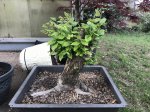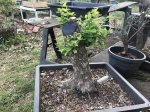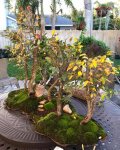You are using an out of date browser. It may not display this or other websites correctly.
You should upgrade or use an alternative browser.
You should upgrade or use an alternative browser.
Collected Winged bark elm .
- Thread starter Bonsailane
- Start date
Random User
Guest
- Messages
- 1,313
- Reaction score
- 1,168
I suspect, if you are going to leave it alone to re-establish a good root system, you won't be hollowing it out. ("Personally", and thats just my taste)... personally, I think few elms (in particular) would really represent well if they are hollowed out... However, if you managed to get one that the average Joe liked, you'd probably have a killer tree on your hands...
You obviously have preferences in the way that you do things, but "if it were mine" I'd cover those roots and see what might develop off of the one heading off to the left in the second last picture... and I suspect that there is a lack of roots under the facing portion of the trunk in the last picture, right?... I'd heap that pan with your medium and try to get more roots to select from.
BUT, we don't get winged elms in my area, so I've never messed with them... I suspect they'd be a lot like white elm though...
You obviously have preferences in the way that you do things, but "if it were mine" I'd cover those roots and see what might develop off of the one heading off to the left in the second last picture... and I suspect that there is a lack of roots under the facing portion of the trunk in the last picture, right?... I'd heap that pan with your medium and try to get more roots to select from.
BUT, we don't get winged elms in my area, so I've never messed with them... I suspect they'd be a lot like white elm though...
Bonsai Nut
Nuttier than your average Nut
I am going to be harsh here, but you can yell at me later  I am going to post this as if I was the owner of this tree and I was talking to myself
I am going to post this as if I was the owner of this tree and I was talking to myself 
I think this is an unpromising piece of material in it's current state. I think the one positive thing it has going for it is girth. The nebari is really problematic - particularly since there was a big surface root you had to chop and the best you can hope for is a huge scar on the side of the nebari.
So my advice is to start over. Let all that new growth run free. Then the moment it hardens I would airlayer right above your current surface roots. Get good roots and a nice flare at the base, and consider reducing the trunk a couple more inches in the spring - but instead of an angled cut go with a flat cut and hollow out the interior so it looks like a volcano. Then seal it with cut paste and not pruner's sealant.
If everything works well, you will get strong roots on the edge of that cut and be on your way to a killer broom style tree
I think this is an unpromising piece of material in it's current state. I think the one positive thing it has going for it is girth. The nebari is really problematic - particularly since there was a big surface root you had to chop and the best you can hope for is a huge scar on the side of the nebari.
So my advice is to start over. Let all that new growth run free. Then the moment it hardens I would airlayer right above your current surface roots. Get good roots and a nice flare at the base, and consider reducing the trunk a couple more inches in the spring - but instead of an angled cut go with a flat cut and hollow out the interior so it looks like a volcano. Then seal it with cut paste and not pruner's sealant.
If everything works well, you will get strong roots on the edge of that cut and be on your way to a killer broom style tree
Random User
Guest
- Messages
- 1,313
- Reaction score
- 1,168
I am going to be harsh here, but you can yell at me laterI am going to post this as if I was the owner of this tree and I was talking to myself
I think this is an unpromising piece of material in it's current state. I think the one positive thing it has going for it is girth. The nebari is really problematic - particularly since there was a big surface root you had to chop and the best you can hope for is a huge scar on the side of the nebari.
So my advice is to start over. Let all that new growth run free. Then the moment it hardens I would airlayer right above your current surface roots. Get good roots and a nice flare at the base, and consider reducing the trunk a couple more inches in the spring - but instead of an angled cut go with a flat cut and hollow out the interior so it looks like a volcano. Then seal it with cut paste and not pruner's sealant.
If everything works well, you will get strong roots on the edge of that cut and be on your way to a killer broom style tree
I can't be that blunt with someone who's never pissed me off...
I missed the cut off root in the second picture... you got this tree from a side-hill, right? (or really uneven ground?)
Bonsailane
Mame
Thanks for the input,,,,
My plan is to shorten it ( in the second to last picture there is some small growth under all the top growth . I think that will be a nice height) from there down And do a angled Hollowed trunk all the way to the root that I add to cut off .
My plan is to shorten it ( in the second to last picture there is some small growth under all the top growth . I think that will be a nice height) from there down And do a angled Hollowed trunk all the way to the root that I add to cut off .
lieuz
Chumono
That's really thoughtful insight sir. Just out of curiosity, given that this is beyond hardwood, how hard is it to air layer this?So my advice is to start over. Let all that new growth run free. Then the moment it hardens I would airlayer right above your current surface roots. Get good roots and a nice flare at the base
Bonsai Nut
Nuttier than your average Nut
That's really thoughtful insight sir. Just out of curiosity, given that this is beyond hardwood, how hard is it to air layer this?
Easy. Elms are one of the easiest genera to air-layer. Eastern winged elms are a little slower than Chinese elms, but not by much. I have air-layered winged elms as well as just propagated them by cuttings. The cuttings I just stuck in bonsai soil mix - no rooting hormone - and protected them from direct sun and wind and they rooted.
lieuz
Chumono
@Bonsai Nut thank you sir. That's useful info!
Tycoss
Chumono
The tree has nice aged bark and, as Bonsai Nut said, girth. Hollowing it to make a sort of Walter Pall "fairytale bonsai" may be an option as well, if that aesthetic appeals to you. Google some of these for ideas. If you want something more traditional and conventionally beautiful, broom is the way to go. Either way, it's a long term project and addressing the weird nebari and lack of taper will be first priority. If you start by removing defects and re assess each time, you should do well. The downside is this will take time, but on the upside, you have an almost clean slate to work with once the nebari is dealt with.
evolutionrevolution
Mame
I have an elm with nebari issues like this.
Have you considered root grafts? that's my plan.
Have you considered root grafts? that's my plan.
thumblessprimate1
Masterpiece
There's no flare at the base, i think it'd be better to start over with air layer.
willhopper
Shohin
Does Winged Elm = Cedar Elm? Our cedar elms are winged
rockm
Spuds Moyogi
No. Cedar elm sometimes develops wings on new growth. Cedar elm also has a vastly more restricted range than winged elm--but it is the most common elm species in Texas. There is an isolated population of the tree in Fla. too. Winged elm ranges over most of the southeast and into the northeast. It's common too.Does Winged Elm = Cedar Elm? Our cedar elms are winged
In cedar elm's native range, I suspect there is considerable interbreeding between the two species.
The leaves are different for both species too. Winged elm leaves tend to be larger. Cedar elm leaves can be tiny, less than a half inch long by 1/4 inch wide and oblong oval shaped...
https://npsot.org/wp/story/2011/1687/
Last edited:
Giga
Masterpiece
though elm grow super fast, so it'll develop fast
markyscott
Imperial Masterpiece
No. Cedar elm sometimes develops wings on new growth. Cedar elm also has a vastly more restricted range than winged elm--but it is the most common elm species in Texas. There is an isolated population of the tree in Fla. too. Winged elm ranges over most of the southeast and into the northeast. It's common too.
In cedar elm's native range, I suspect there is considerable interbreeding between the two species.
The leaves are different for both species too. Winged elm leaves tend to be larger. Cedar elm leaves can be tiny, less than a half inch long by 1/4 inch wide and oblong oval shaped...
https://npsot.org/wp/story/2011/1687/
Actually, I don’t think that Winged elm and Cedar elm can hybridize (naturally at least). Cedar elm is a fall flowering elm. It is one of two fall flowering elms in the US - the other is the September elm, but “that boy ain’t from around here”. Winged elm is a spring flowering elm. I believe that the Chinese elm is a fall flowering elm - with the number of those that have been introduced here in Houston, it’s possible that might produce hybrids with the Cedar elm.
There’s a nice discussion of the various characteristics in this thread:
https://www.bonsainut.com/threads/collected-winged-elm.23095/#post-348106
Scott
rockm
Spuds Moyogi
you may be right. I've seen some variation in cedar elms in east Texas and the hill country. Could be local varieties...Actually, I don’t think that Winged elm and Cedar elm can hybridize (naturally at least). Cedar elm is a fall flowering elm. It is one of two fall flowering elms in the US - the other is the September elm, but “that boy ain’t from around here”. Winged elm is a spring flowering elm. I believe that the Chinese elm is a fall flowering elm - with the number of those that have been introduced here in Houston, it’s possible that might produce hybrids with the Cedar elm.
Scott
willhopper
Shohin
Our cedar elms are from Texas and their leaves are bigger than described above.
markyscott
Imperial Masterpiece
Our cedar elms are from Texas and their leaves are bigger than described above.
Everything is bigger in Texas.
willhopper
Shohin
Bonsai Nut
Nuttier than your average Nut
Cedar elms have different wings, and they are a different color than the Eastern winged elms.
Cedar elm wings are less pronounced and are tan or a light brown in color. Winged elm wings are longer, and are grey in color. If you see the two trees next to each other, they are very different.
If it is from anywhere other than Texas, it is almost 100% guaranteed to be Eastern winged elm. From Texas you will have to investigate further
Cedar elm wings are less pronounced and are tan or a light brown in color. Winged elm wings are longer, and are grey in color. If you see the two trees next to each other, they are very different.
If it is from anywhere other than Texas, it is almost 100% guaranteed to be Eastern winged elm. From Texas you will have to investigate further
Similar threads
- Replies
- 9
- Views
- 481
- Replies
- 2
- Views
- 133






